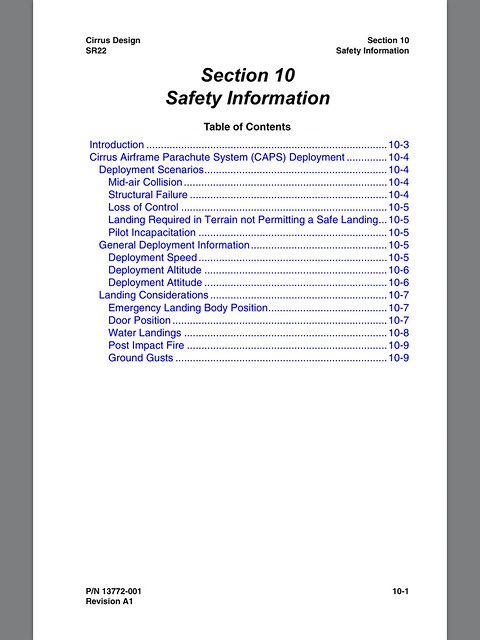When To Pull The Chute
Moderator: drseti
When To Pull The Chute
......
Last edited by CTLSi on Mon Dec 01, 2014 6:28 pm, edited 1 time in total.
- FastEddieB
- Posts: 2880
- Joined: Wed Jan 07, 2009 9:33 pm
- Location: Lenoir City, TN/Mineral Bluff, GA
Re: When To Pull The Chute
Cirrus, for one, has many pages devoted to the chute in the POH, including a list of deployment scenarios.CTLSi wrote:
Those who own aircraft with BRS must still be wondering since nothing in company literature, in general aviation discussion, or in the aircraft AOI, or POH from any of these companies seems to offer emphatic and consistent answers.

Re: When To Pull The Chute
Odd that they don't have a section listed as "Motor Loss on T/O" but I suppose that's covered in minimum altitudes.
Lately I've been thinking of the chute more on Motor Loss on T/O. Pulling the chute would not be fun, but that scenario is just so limited, with results without the chute often being quite bad.
I'm a "fly the plane first" guy as much as anyone (so I think), have practiced that scenario in training.
In reality I'm thinking:
1) fly with the BRS pin out
2) if motor loss on T/O over 250'... pull the chute unless there are clearly better options.
The opposite argument could be, an LSA could be glided down on "anything" so slowly which combined with low kinetic energy could be highly survivable. Yet I personally know of a non-BRS LSA incident where that didn't work out so well.
Off-field landings in text book are pretty benign.
The reality is that it's probably going to be nasty if you catch that nosewheel on irregular terrain.
... just one man's thoughts.
More experienced points of view?
Lately I've been thinking of the chute more on Motor Loss on T/O. Pulling the chute would not be fun, but that scenario is just so limited, with results without the chute often being quite bad.
I'm a "fly the plane first" guy as much as anyone (so I think), have practiced that scenario in training.
In reality I'm thinking:
1) fly with the BRS pin out
2) if motor loss on T/O over 250'... pull the chute unless there are clearly better options.
The opposite argument could be, an LSA could be glided down on "anything" so slowly which combined with low kinetic energy could be highly survivable. Yet I personally know of a non-BRS LSA incident where that didn't work out so well.
Off-field landings in text book are pretty benign.
The reality is that it's probably going to be nasty if you catch that nosewheel on irregular terrain.
... just one man's thoughts.
More experienced points of view?
- FastEddieB
- Posts: 2880
- Joined: Wed Jan 07, 2009 9:33 pm
- Location: Lenoir City, TN/Mineral Bluff, GA
Re: When To Pull The Chute
And did we not have a CT land in a (soccer?) field that appeared custom made for an off airport landing, and yet still flip?designrs wrote:Yet I personally know of a non-BRS LSA incident where that didn't work out so well.
Off-field landings in text book are pretty benign.
The reality is that it's probably going to be nasty if you catch that nosewheel on irregular terrain.
In reality I'm thinking:
1) fly with the BRS pin out
2) if motor loss on T/O over 250'... pull the chute unless there are clearly better options.
Pin out - always when in flight.
In a Cirrus, I believe the "CAPS Alive" call comes at 500'.
Below that, it would be very hard to react in time, but if you could and there were no other good options, it couldn't hurt and would likely dissipate a bunch of energy before impact.
That "BRS Alive" altitude might be slightly lower in a CT, but if the POH does not address it I'd check with the chute provider for guidance.
Anyway, I will bow out of this discussion now, since the topic has been discussed ad nauseum on this site and elsewhere. The "search" function would serve one well in that regard.
In closing, I will again link to this video by Rick Beach which analyzes Cirrus CAPS events in detail. Well worth a watch if you fly a Cirrus or any plane with BRS.
https://www.youtube.com/watch?v=Pc6v-hWCSqc